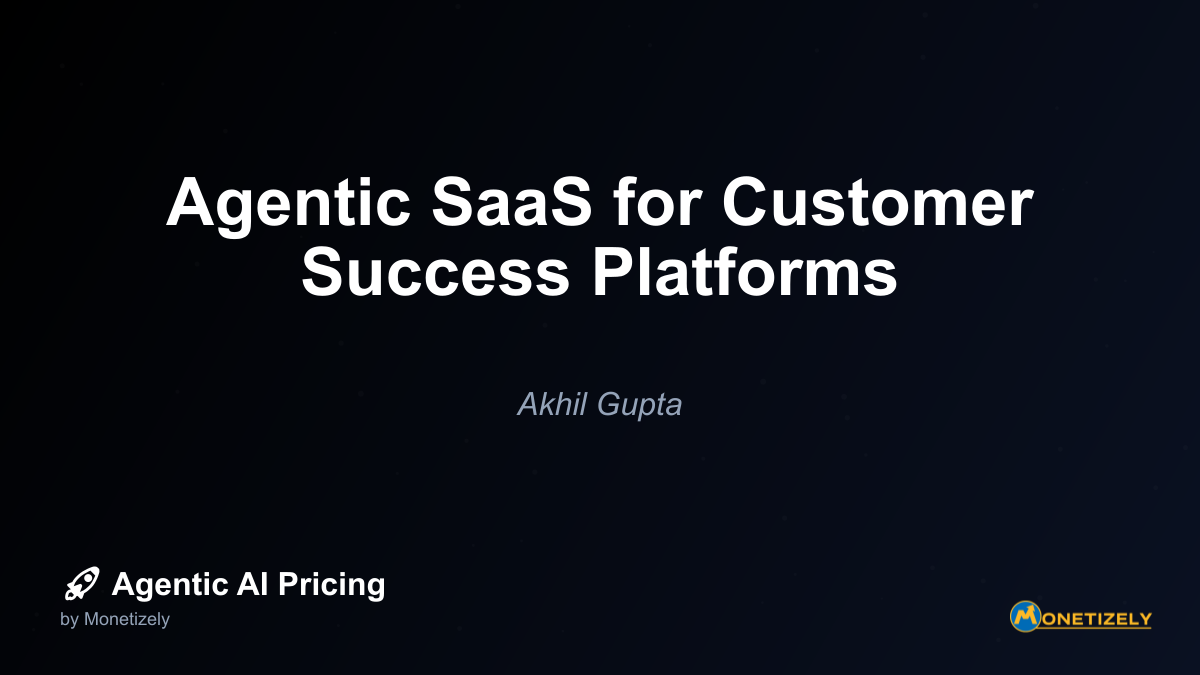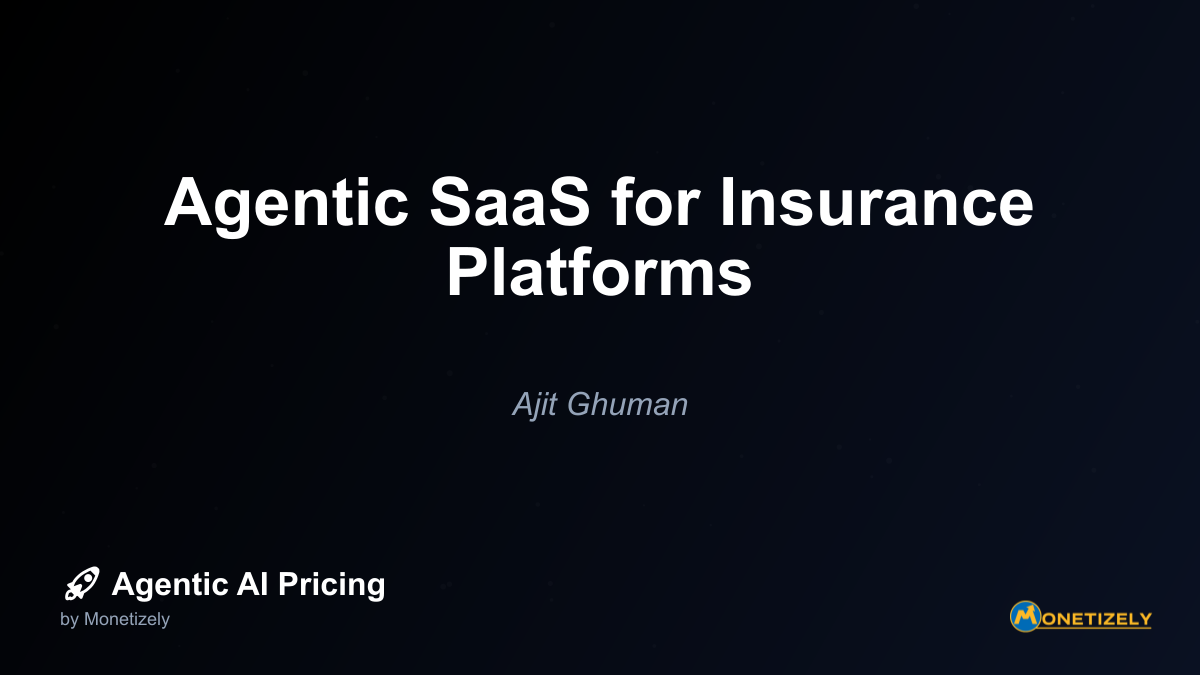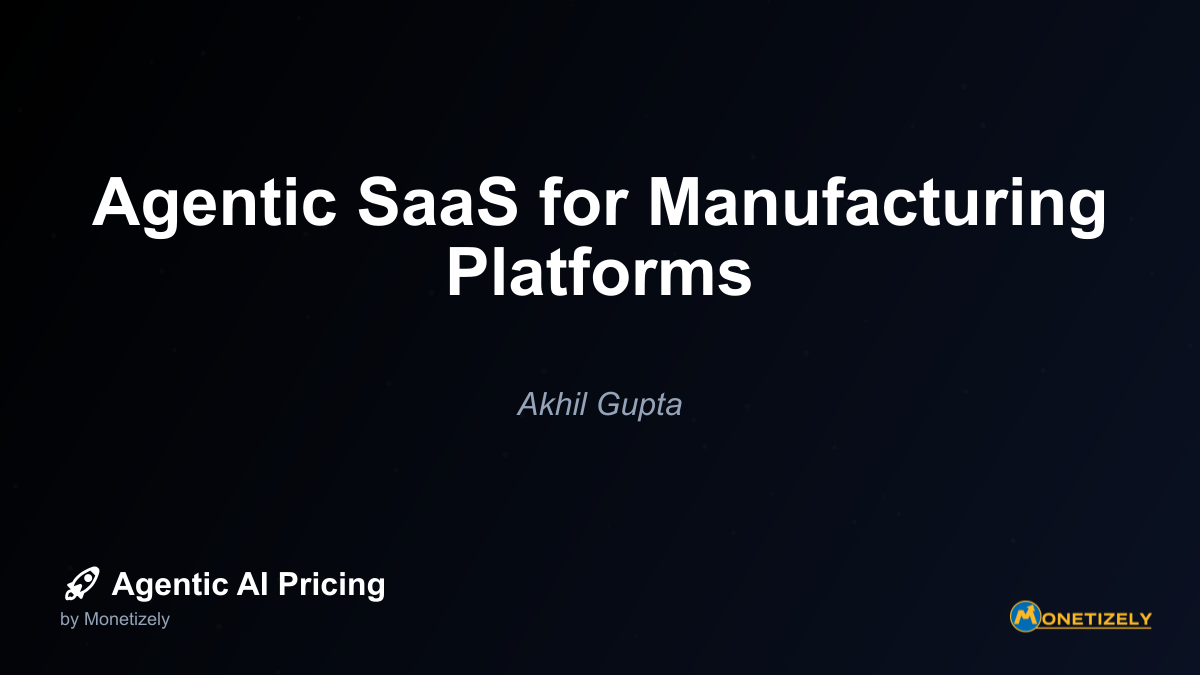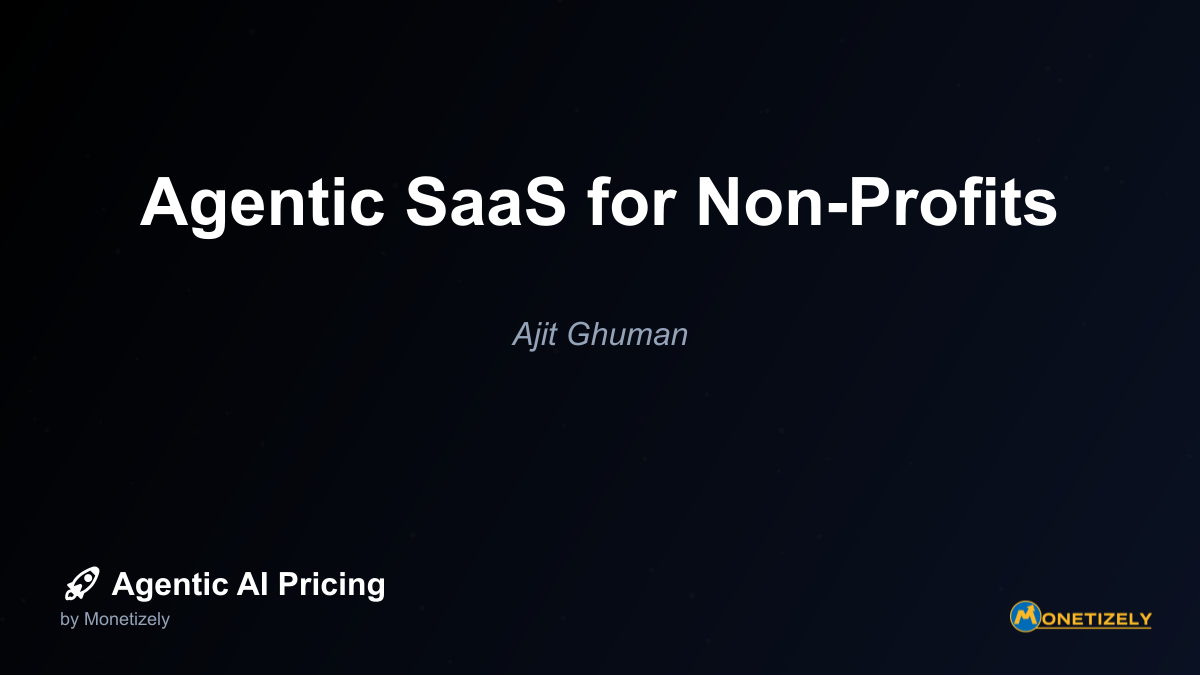· Akhil Gupta · Vertical Applications · 6 min read
Agentic SaaS in Travel Operations
AI and SaaS Pricing Masterclass
Learn the art of strategic pricing directly from industry experts. Our comprehensive course provides frameworks and methodologies for optimizing your pricing strategy in the evolving AI landscape. Earn a professional certification that can be imported directly to your LinkedIn profile.
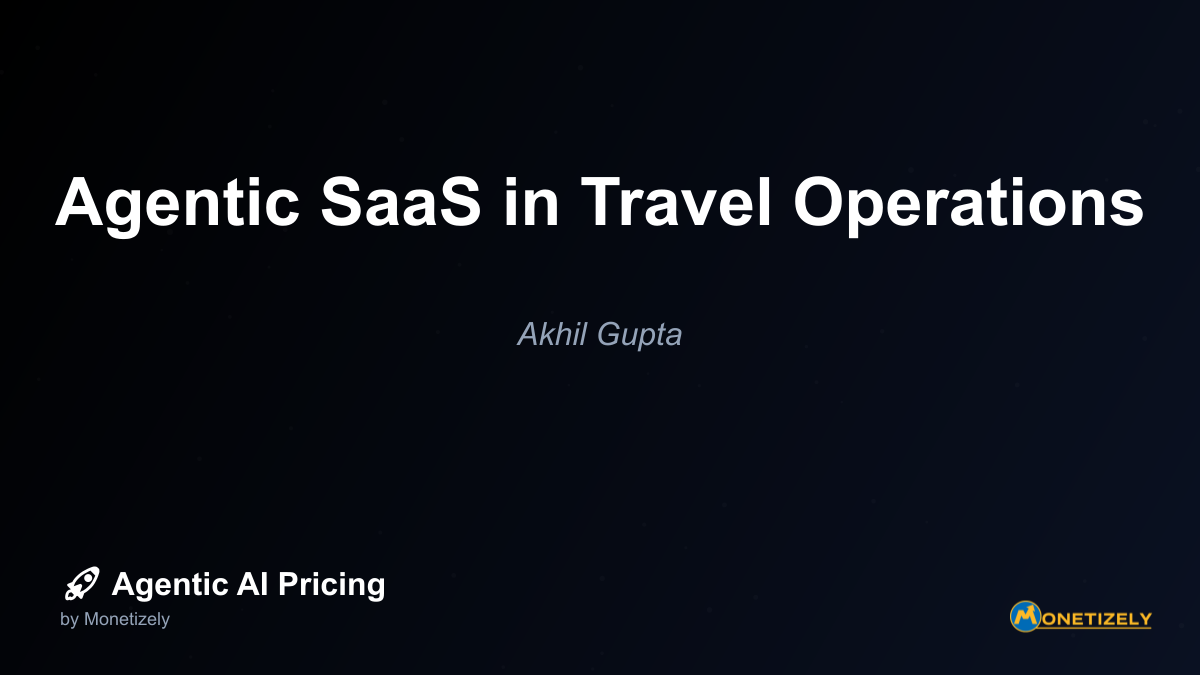
Pricing Models for Agentic SaaS in Travel Operations
The adoption of agentic AI solutions in travel operations introduces new considerations for pricing models. Unlike traditional software with straightforward licensing structures, agentic systems often deliver value in ways that aren’t easily captured by conventional pricing approaches.
Value-Based Pricing Structures
Forward-thinking vendors in this space are increasingly adopting value-based pricing models that align costs with measurable business outcomes. These might include:
Efficiency Gains: Pricing based on documented reductions in operational costs or labor hours.
Revenue Enhancement: Compensation tied to incremental revenue generated through improved inventory management or dynamic pricing.
Performance Improvements: Fees structured around measurable improvements in key performance indicators like on-time departures or check-in times.
For example, an agentic revenue management system might charge a base subscription fee plus a percentage of the documented revenue lift attributable to its recommendations.
Hybrid Consumption Models
Many providers are implementing hybrid pricing structures that combine:
Base Platform Fee: Covering the core functionality and standard integrations.
Usage-Based Components: Charges based on the volume of transactions, decisions, or other measurable usage metrics.
Premium Features: Add-on capabilities for specialized functions that can be activated as needed.
This approach allows travel companies to start with modest investments and scale their usage as they realize benefits, making adoption less risky.
Learn more about integration pricing models for agentic AI systems that connect with existing travel technology infrastructure.
Implementation Challenges and Success Factors
While the potential benefits of agentic SaaS for travel operations are substantial, successful implementation requires careful planning and execution.
Data Quality and Accessibility
Agentic systems rely on high-quality, accessible data to deliver value. Travel companies often face challenges with:
Data Silos: Information trapped in legacy systems with limited integration capabilities.
Inconsistent Formats: Variations in how similar data is structured across different systems.
Historical Limitations: Insufficient historical data to train effective AI models.
Successful implementations typically begin with data preparation initiatives that address these issues before full deployment.
Change Management and Skill Development
The introduction of agentic systems represents a significant change in how operational teams work. Key considerations include:
Role Evolution: Helping staff transition from transactional tasks to more strategic, exception-handling roles.
Trust Building: Establishing confidence in AI-generated recommendations through transparent explanations and proven results.
Skill Development: Training team members to effectively collaborate with and oversee agentic systems.
Organizations that invest in these human factors typically see faster adoption and better results from their agentic implementations.
Governance and Control Frameworks
As agentic systems take on more autonomous decision-making, establishing appropriate governance becomes critical:
Decision Boundaries: Clearly defining which decisions can be fully automated versus those requiring human review.
Performance Monitoring: Implementing systems to track and evaluate the quality of AI-driven decisions.
Override Mechanisms: Creating efficient processes for human intervention when necessary.
Continuous Improvement: Establishing feedback loops that help agentic systems learn from exceptions and corrections.
Case Study: Major International Hotel Chain
A leading international hotel chain with over 500 properties implemented an agentic back-office system across their operations with notable results:
- Staff Scheduling: 14% reduction in labor costs while maintaining service standards
- Inventory Management: 9% increase in RevPAR through optimized room inventory allocation
- Maintenance Operations: 22% decrease in guest complaints related to room maintenance issues
- Energy Management: 17% reduction in energy costs through intelligent climate control
- Financial Processing: 35% decrease in invoice processing time and 42% reduction in payment errors
The implementation followed a phased approach, starting with a pilot in 25 properties before expanding across the network. Key success factors included:
- Extensive data preparation and integration work before deployment
- Clear definition of success metrics and ROI expectations
- Comprehensive change management program for operational staff
- Executive sponsorship and visible leadership support
- Iterative implementation with frequent reassessment and adjustment
Case Study: Regional Airline Operations
A mid-sized regional airline serving approximately 50 destinations implemented agentic systems for crew management and operational control with these outcomes:
- Crew Utilization: 11% improvement in crew utilization efficiency
- Disruption Management: 27% reduction in passenger delay minutes during irregular operations
- Maintenance Planning: 15% decrease in unscheduled maintenance events
- Fuel Optimization: 4.2% reduction in fuel consumption through optimized flight planning
- Customer Recovery: 31% improvement in rebooking efficiency during disruptions
The airline noted that the most significant value came from the system’s ability to rapidly recalculate optimal solutions during operational disruptions, a capability that far exceeded what human planners could accomplish in time-sensitive situations.
The Future of Agentic SaaS in Travel Operations
As agentic technologies continue to evolve, several emerging trends will shape their application in travel operations:
Multi-Agent Ecosystems
Rather than monolithic systems, we’re likely to see ecosystems of specialized agents that collaborate to manage different aspects of operations. For example, separate but coordinated agents might handle crew scheduling, maintenance planning, and customer service, sharing information and coordinating decisions.
Human-AI Collaboration Models
The most effective implementations will likely be those that thoughtfully divide responsibilities between human operators and AI systems, leveraging the strengths of each. This might involve AI handling routine decisions and pattern recognition while humans provide strategic guidance and manage exceptions.
Predictive to Prescriptive Evolution
Current systems are primarily focused on predicting what will happen (predictive analytics) and recommending actions. Future systems will increasingly move toward prescriptive capabilities—autonomously taking actions based on those predictions within carefully defined parameters.
Cross-Organization Optimization
As adoption increases, we may see agentic systems that optimize across organizational boundaries—for example, coordinating between airlines and hotels to manage disruptions in ways that minimize passenger inconvenience.
Discover how analytics tools can help optimize AI agent pricing for travel operations systems.
Implementation Roadmap for Travel Companies
For travel organizations considering agentic SaaS adoption for back-office operations, a structured approach can help maximize success:
Phase 1: Assessment and Strategy (2-3 months)
- Current State Analysis: Document existing processes, systems, and pain points.
- Opportunity Identification: Prioritize areas where agentic systems can deliver the greatest value.
- Data Readiness Evaluation: Assess the quality and accessibility of required data.
- Business Case Development: Create ROI projections and success metrics.
Phase 2: Pilot Implementation (3-6 months)
- Vendor Selection: Evaluate and select appropriate technology partners.
- Scope Definition: Clearly define the parameters of the pilot project.
- Data Preparation: Clean and integrate necessary data sources.
- Limited Deployment: Implement in a controlled environment.
- Performance Measurement: Rigorously track outcomes against baselines.
Phase 3: Operational Integration (6-12 months)
- Process Redesign: Adapt operational processes to leverage agentic capabilities.
- Change Management: Prepare and train staff for new ways of working.
- Systems Integration: Connect agentic systems with existing technology infrastructure.
- Governance Implementation: Establish oversight and control mechanisms.
Phase 4: Expansion and Optimization (Ongoing)
- Capability Expansion: Gradually increase the scope of agentic decision-making.
- Continuous Learning: Implement feedback loops for ongoing improvement.
- Advanced Use Cases: Explore more sophisticated applications as confidence grows.
- Cross-Functional Integration: Connect previously siloed operational areas.
Conclusion: The Competitive Imperative
For airlines and hotels, the adoption of agentic SaaS for back-office operations is rapidly moving from competitive advantage to competitive necessity. The operational efficiencies, cost savings, and service improvements enabled by these technologies are too significant to ignore in an industry with notoriously thin margins.
The most successful organizations will be those that approach implementation thoughtfully—starting with clear business objectives, investing in data quality and change management, and establishing appropriate governance frameworks. By following a structured roadmap and learning from early adopters, travel companies can transform their operations while managing implementation risks.
As agentic technologies continue to evolve, the gap between leaders and laggards will likely widen. Forward-thinking travel companies are already moving beyond pilot projects to enterprise-wide implementations, setting new standards for operational efficiency and service delivery that will reshape customer expectations and industry economics.
The journey toward fully agentic operations will be gradual rather than revolutionary, but the direction is clear. For travel industry executives, the question is no longer whether to embrace these technologies, but how quickly and effectively they can be implemented to deliver measurable business value.
Co-Founder & COO
Akhil is an Engineering leader with over 16+ years of experience in building, managing and scaling web-scale, high throughput enterprise applications and teams. He has worked with and led technology teams at FabAlley, BuildSupply and Healthians. He is a graduate from Delhi College of Engineering and UC Berkeley certified CTO.
Pricing Strategy Audit
Let our experts analyze your current pricing strategy and identify opportunities for improvement. Our data-driven assessment will help you unlock untapped revenue potential and optimize your AI pricing approach.

